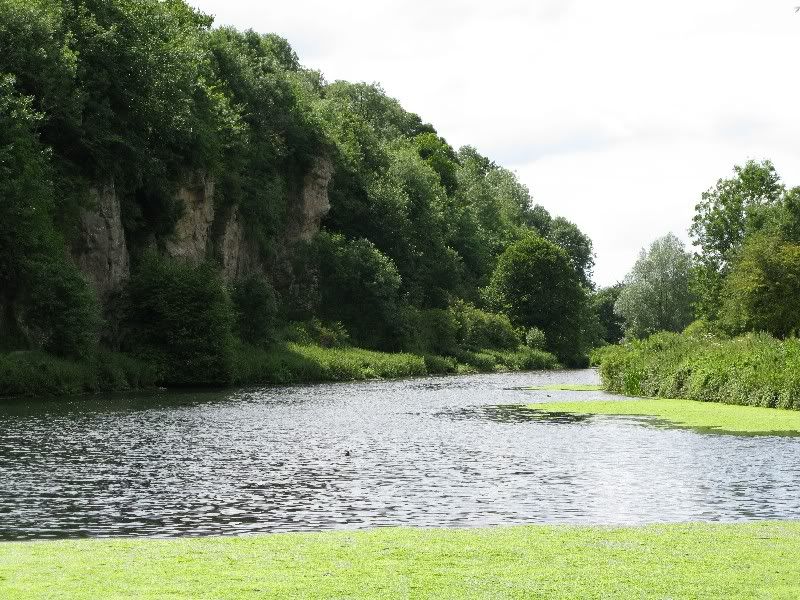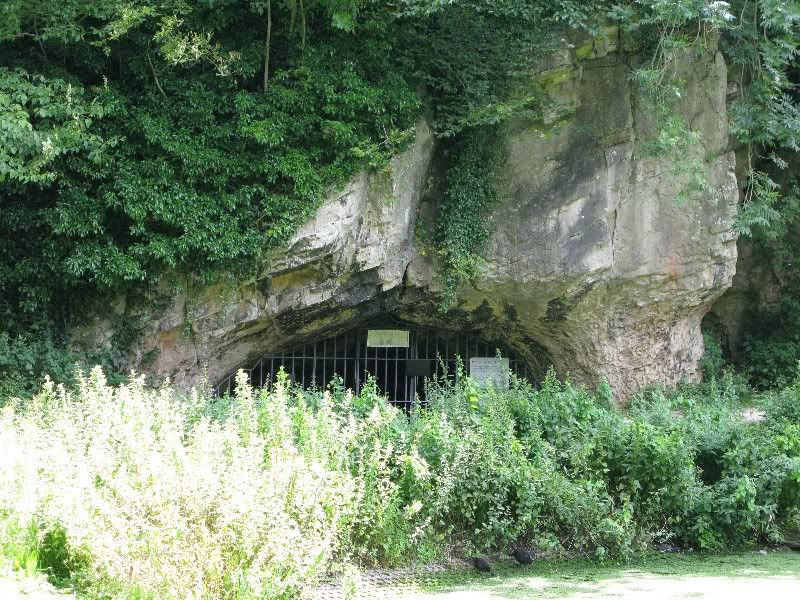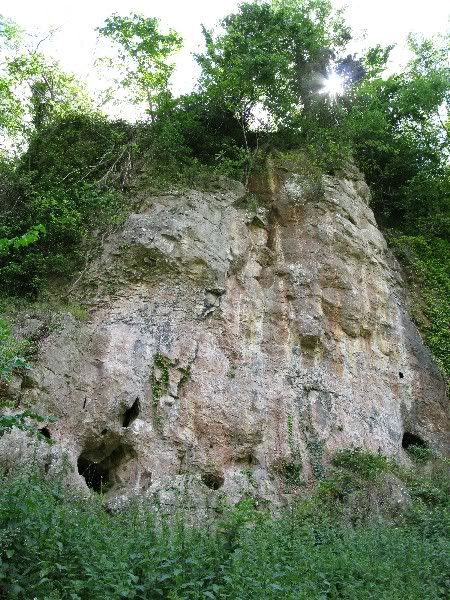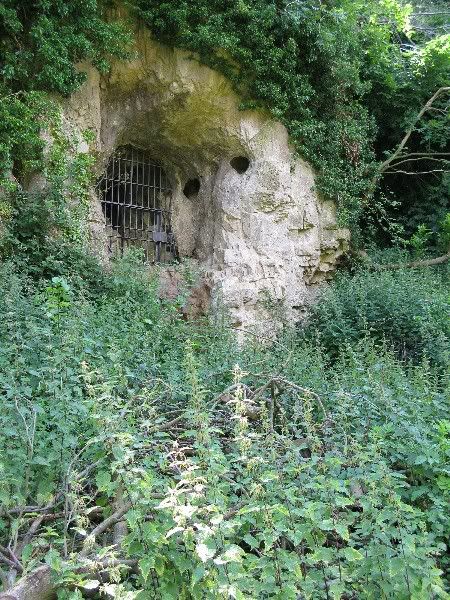Cresswell Crags Cave Art
Until recently it was believed that people visiting and using caves in Britian during the Ice Age were not decorating the caves with pictures of animals and other markings. This was despite having all the necessary tools and materials, ochre, manganese and charcoal.
However, a team of archaeologists made a remarkable discovery at Creswell Crags in April 2003. They found the first and only example of rock art from the Ice Age. All of the pictures found were engraved into the rock and as far as is known colour was not applied to the figures.
The pictures range from complete figures of animals to geometric shapes and individual vertical lines.
Close to the entrance in Church Hole, on a flat surface of rock, is an engraving of an ibex, a goat-like animal. Beneath the figure Ice Age hunters have engraved a series of vertical lines. Deeper within Church Hole, engraved figures were found and are believed to be birds with long necks.
Why are works of art like the Robin Hood Cave horse so rare in England?
It is likely that Stone Age people did not settle at Creswell Crags for long periods of time but visited for a short season. People on the move, nomadic hunters, may not have wanted to carry anything but essential equipment around with them and may have avoided producing valuable items while they were here.
They may also have practised art in forms which do not survive today. For example, they might have painted their bodies and braided their hair with shells and feathers. They may have sewn patterns into their clothes using different colour furs and skins.
In order for the stone age artists to leave their engravings they would have used Stone tools such as burins that are excellent for engraving outlines, modelling and sculpturing bone and antler. The burin was used and held like a modern pencil.
It appears that cresswell crags is one of very few sites in the UK that actually has cave art leading to the possibility that ancient inhabitence of this country were very nomadic and moved frequently, possibly not having the time to paint and leave there mark. But for the ones that did find the time they have left large clues as to what type of animals they hunted and ate.
What tools did ancient man have?
As far as we know ancient man would have used natural materials such as wood and stone. As for how they came about making such tools is a harder question to answer.
One possible answer is that the first tools were discovered by accident, i.e. a "caveman" is stalking his pray and it turns on him, he falls picks up a large stick and hits the animal with it! now sencing that he has just made his life easier by using a big heavy stick to kill somthing he has just created his first tool. Now It could be assumed that the other people in his hunting party would have witnessed this use of the "tool" and have decided that it would be better to go hunting with big heavy sticks, instead of hitting an animal to death with there bear hands.
Fire
It is believed by some that FIRE was first created by lightening. Caveman saw the fire and was attracted to it. Maybe they would have thought that a part of the sun had broken off and fallen to earth. It is believed that fire was first used and controlled by caveman about 1,420,000 years ago. Although caveman did not know how to create fire himself using friction or flint until about 7000B.C. Fire was used to keep warm, cook, illuminate and later to clear forests of trees to create open areas to better hunt animals.
At some point in early mans progress, the ability to create fire was discovered. It may have been by accident, noone knows for sure as there are no written records. But we do know that when early man did know how to make fire he used flint and friction meathods.
Fire by Friction
Rather than creating a spark into tinder, fire by friction causes the fuel to heat up until it reaches the combustion temperature and ignites. This is around 800 degrees fahrenheit. Moisture is the biggest obstacle to overcome when attempting to create fire by rubbing wood. Start with extremely dry wood and keep it dry to ensure success. In areas of higher humidity, more effort is required.
Following are some of the more common methods of creating fire by friction in order of increasing complexness. All of these methods create a coal of smoldering wood dust which is then transfered to waiting tinder to be coaxed into flame. They also employ one piece of hard wood and another slightly softer wood which wears away. Neither of these woods should be too soft nor too hard. Excessive resin in the wood will also cause failure since it will cause the wood to become polished and smooth.
These are simple introductions to each method. Individual success depends on strength, practice, materials used, and troubleshooting. These methods require a lot of effort and consistency.
Some woods to consider using:
Cedar
Willow and Redwood
Yucca and Oak
One meathod of fire lighting that could have been discovered by accident is the fire plough, the individual could have been trying to shape a piece of wood when he saw smoke, below I have detailed how this works;
Form a plow board of softer wood that is flat and a couple inches across and 2 feet long.
Form a plow stick that is hardwood and has a sharpened tip.
Cut or rub a depression about 6 or 8 inches long in the plow board. This is the trough in which you will scrape the plow stick.
Hold the plow board firm as shown or kneel on it or sit on it if it is a longer board. The idea is to keep the board steady.
Point the plow stick into the plow board at about a 60 degree angle and push it forward with downward pressure.
Release the downward pressure and pull the plow stick back to the start of the trough.
Push and pull the plow stick quickly, creating wood dust at the far end of the trough. It is important to end each stroke at the same spot so dust can accumulate there.
Eventually, the wood dust will combust and can be pushed into waiting tinder. (From Ray Mears Survival)
Tools
Cutting tools for early man would have not have been made from steels, they would have been fasioned from pieces of stone, the process of making such tools is a highly skilled procedure called flint knapping, that today people would be hard pressed to learn, but for early man the only way to get a cutting tool was by making one. Other tools were fassioned from materials that were redily available, such as wood, bone and antler.
Out of these materials early man was able to create spears and bows, that were highly efficient killing tools.
As far as other tools like baskets and carrying devices are concerned, there is no physical evidence that they were used, yet it does seem likely that early man would have had to construct some sort of "bag" to carry his every day essentials.
I can possibly catagorise clothing as a tool, these were made from animal hides, probably cut using the stone tools mentioned earlier, clothing would have been functional not fassionable. Looking at bushcraft skills used today, especially the production of cordage (string) we must assume that early man also had the knowledge of what plants were useful for what purpose. One of the most important Cro-Magnon inventions was the needle. Needles were made out of slivers of animal bone; they were sharpened to a point at one end and had an eye at the other end. With a needle, Cro-Magnon man could sew carefully cut pieces of fur into better fitting garments. Evidence suggests that Cro-Magnon people developed close-fitting pants and shirts that would protect them from the cold, as well as shawls, hoods, and long boots. Because they had not learned how to tan hides to soften them, the animal skin would have been stiff at first, but with repeated wearings it would become very soft and comfortable. Jacquetta Hawkes, author of The Atlas of Early Man, believes that Cro-Magnon clothes approached those of modern Eskimos in their excellence of construction.
Society of early man is possibly the hardest thing to either prove or disprove, we know that early man somtimes used caves as refuge, evidence of this can be found in places such as Cresswell Crags in Derbyshire, where cave paintings and stone tools have been discovered, but as to how many different "families" lived in the area we can only guess. For example, early man may have been teratorial, in which case he would have faught to defend his hunting and foraging rights. As yet we have no clear picture of there society except that they were hunter gatherers.
Until recently it was believed that people visiting and using caves in Britian during the Ice Age were not decorating the caves with pictures of animals and other markings. This was despite having all the necessary tools and materials, ochre, manganese and charcoal.
However, a team of archaeologists made a remarkable discovery at Creswell Crags in April 2003. They found the first and only example of rock art from the Ice Age. All of the pictures found were engraved into the rock and as far as is known colour was not applied to the figures.
The pictures range from complete figures of animals to geometric shapes and individual vertical lines.
Close to the entrance in Church Hole, on a flat surface of rock, is an engraving of an ibex, a goat-like animal. Beneath the figure Ice Age hunters have engraved a series of vertical lines. Deeper within Church Hole, engraved figures were found and are believed to be birds with long necks.
Why are works of art like the Robin Hood Cave horse so rare in England?
It is likely that Stone Age people did not settle at Creswell Crags for long periods of time but visited for a short season. People on the move, nomadic hunters, may not have wanted to carry anything but essential equipment around with them and may have avoided producing valuable items while they were here.
They may also have practised art in forms which do not survive today. For example, they might have painted their bodies and braided their hair with shells and feathers. They may have sewn patterns into their clothes using different colour furs and skins.
In order for the stone age artists to leave their engravings they would have used Stone tools such as burins that are excellent for engraving outlines, modelling and sculpturing bone and antler. The burin was used and held like a modern pencil.
It appears that cresswell crags is one of very few sites in the UK that actually has cave art leading to the possibility that ancient inhabitence of this country were very nomadic and moved frequently, possibly not having the time to paint and leave there mark. But for the ones that did find the time they have left large clues as to what type of animals they hunted and ate.
What tools did ancient man have?
As far as we know ancient man would have used natural materials such as wood and stone. As for how they came about making such tools is a harder question to answer.
One possible answer is that the first tools were discovered by accident, i.e. a "caveman" is stalking his pray and it turns on him, he falls picks up a large stick and hits the animal with it! now sencing that he has just made his life easier by using a big heavy stick to kill somthing he has just created his first tool. Now It could be assumed that the other people in his hunting party would have witnessed this use of the "tool" and have decided that it would be better to go hunting with big heavy sticks, instead of hitting an animal to death with there bear hands.
Fire
It is believed by some that FIRE was first created by lightening. Caveman saw the fire and was attracted to it. Maybe they would have thought that a part of the sun had broken off and fallen to earth. It is believed that fire was first used and controlled by caveman about 1,420,000 years ago. Although caveman did not know how to create fire himself using friction or flint until about 7000B.C. Fire was used to keep warm, cook, illuminate and later to clear forests of trees to create open areas to better hunt animals.
At some point in early mans progress, the ability to create fire was discovered. It may have been by accident, noone knows for sure as there are no written records. But we do know that when early man did know how to make fire he used flint and friction meathods.
Fire by Friction
Rather than creating a spark into tinder, fire by friction causes the fuel to heat up until it reaches the combustion temperature and ignites. This is around 800 degrees fahrenheit. Moisture is the biggest obstacle to overcome when attempting to create fire by rubbing wood. Start with extremely dry wood and keep it dry to ensure success. In areas of higher humidity, more effort is required.
Following are some of the more common methods of creating fire by friction in order of increasing complexness. All of these methods create a coal of smoldering wood dust which is then transfered to waiting tinder to be coaxed into flame. They also employ one piece of hard wood and another slightly softer wood which wears away. Neither of these woods should be too soft nor too hard. Excessive resin in the wood will also cause failure since it will cause the wood to become polished and smooth.
These are simple introductions to each method. Individual success depends on strength, practice, materials used, and troubleshooting. These methods require a lot of effort and consistency.
Some woods to consider using:
Cedar
Willow and Redwood
Yucca and Oak
One meathod of fire lighting that could have been discovered by accident is the fire plough, the individual could have been trying to shape a piece of wood when he saw smoke, below I have detailed how this works;
Form a plow board of softer wood that is flat and a couple inches across and 2 feet long.
Form a plow stick that is hardwood and has a sharpened tip.
Cut or rub a depression about 6 or 8 inches long in the plow board. This is the trough in which you will scrape the plow stick.
Hold the plow board firm as shown or kneel on it or sit on it if it is a longer board. The idea is to keep the board steady.
Point the plow stick into the plow board at about a 60 degree angle and push it forward with downward pressure.
Release the downward pressure and pull the plow stick back to the start of the trough.
Push and pull the plow stick quickly, creating wood dust at the far end of the trough. It is important to end each stroke at the same spot so dust can accumulate there.
Eventually, the wood dust will combust and can be pushed into waiting tinder. (From Ray Mears Survival)
Tools
Cutting tools for early man would have not have been made from steels, they would have been fasioned from pieces of stone, the process of making such tools is a highly skilled procedure called flint knapping, that today people would be hard pressed to learn, but for early man the only way to get a cutting tool was by making one. Other tools were fassioned from materials that were redily available, such as wood, bone and antler.
Out of these materials early man was able to create spears and bows, that were highly efficient killing tools.
As far as other tools like baskets and carrying devices are concerned, there is no physical evidence that they were used, yet it does seem likely that early man would have had to construct some sort of "bag" to carry his every day essentials.
I can possibly catagorise clothing as a tool, these were made from animal hides, probably cut using the stone tools mentioned earlier, clothing would have been functional not fassionable. Looking at bushcraft skills used today, especially the production of cordage (string) we must assume that early man also had the knowledge of what plants were useful for what purpose. One of the most important Cro-Magnon inventions was the needle. Needles were made out of slivers of animal bone; they were sharpened to a point at one end and had an eye at the other end. With a needle, Cro-Magnon man could sew carefully cut pieces of fur into better fitting garments. Evidence suggests that Cro-Magnon people developed close-fitting pants and shirts that would protect them from the cold, as well as shawls, hoods, and long boots. Because they had not learned how to tan hides to soften them, the animal skin would have been stiff at first, but with repeated wearings it would become very soft and comfortable. Jacquetta Hawkes, author of The Atlas of Early Man, believes that Cro-Magnon clothes approached those of modern Eskimos in their excellence of construction.
Society of early man is possibly the hardest thing to either prove or disprove, we know that early man somtimes used caves as refuge, evidence of this can be found in places such as Cresswell Crags in Derbyshire, where cave paintings and stone tools have been discovered, but as to how many different "families" lived in the area we can only guess. For example, early man may have been teratorial, in which case he would have faught to defend his hunting and foraging rights. As yet we have no clear picture of there society except that they were hunter gatherers.

 I guess that it is rather less forgivable in engineering than it is in archaeology.
I guess that it is rather less forgivable in engineering than it is in archaeology.




